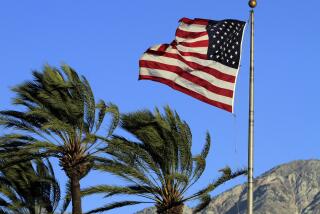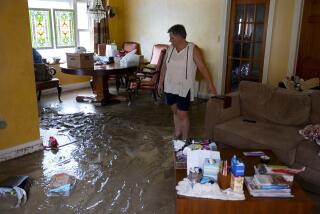Tropical Storm Debby: How a deadly storm got such a cute name
- Share via
Tropical Storm Debby is too cute to resist -- from a safe distance. “Debby Downer” jokes and sly “Debby Does” references have already cropped up on Twitter.
But there’s nothing amusing about a storm that has forced the evacuation of thousands of residents, caused widespread flooding and triggered at least seven tornadoes as it drives eastward into Florida.
One of those tornadoes killed a Venus, Fla., woman who was flung from her mobile home park along with her 3-year-old daughter. When the woman’s body was found, it was still wrapped protectively around her daughter, who survived with injuries, media reported.
Photos: Tropical storm lashes Florida
The labeling and naming of hurricanes is a long-held practice that helps ease communication and tracking -- especially when two or more tropical storms occur at the same time, according to the National Oceanic and Atmospheric Administration.
It’s more art than science, however, and can be fraught with controversy.
Still, there is something about Debby -- perhaps it’s the perky y at the end, reminiscent of a pigtailed schoolgirl practicing penmanship -- that strikes many as being particularly ill-suited for a deadly storm.
From Twitter:
“What kind of name for a storm is ‘Debby?’ Hurricanes should have names like ‘Satan.’ ”
“Tropical storm Debby is going to hit Texas? Can’t wait for the headlines if it reaches Dallas.”
For hundreds of years, the naming hurricanes was a haphazard affair. In the West Indies, hurricanes were named after religious saints. And in the U.S., back when it was up to military forecasters to keep track of such natural occurrences, hurricanes and tropical storms were given a number, not a name.
But numbers weren’t as easy as names for civilians to remember. In subsequent years, the military phonetic alphabet was used to assign names such as Able, Baker and Charlie, according to a history of storm and hurricane names on Weather.com.
In the 1950s, someone got the bright idea to give tropical storms and hurricanes female names, starting in alphabetical order. But with the rise of the feminist movement, many women took offense.
By the late 1970s, both male and female names were being used to label storms. The list has been revised yet again by member nations of the World Meteorological Organization to reflect names commonly found in English, Spanish and French.
Today, commonly agreed-upon lists of tropical storm names are shared internationally for ease of communication and tracking.
There are six lists of tropical cyclone names, 21 names for Atlantic storms and 24 names for eastern North Pacific storms, according to Weather.com. And those lists are also used on a rotating basis.
In a bid for parity, the lists alternate male and female names starting with A. (The lists are 21 names long, skipping names that start with Q, U, X, Y and Z.) Each storm season alternates between starting with a male name or a female name. For example, last year, the list started with Arlene. This year, it started with Alberto.
By and large, the lists seem stacked with names that could become fitting for a natural disaster. But every once in a while, there’s one that sticks out like a sore thumb. Like Debby.
A storm must reach wind speeds of more than 39 mph to warrant an official moniker from the National Hurricane Center.
There is one single exception to these carefully thought-out rotations.
When a storm is exceptionally deadly and destructive, it is officially retired. No one wants to face a second Hurricane Katrina.
ALSO:
Judge orders mom to cut off teen’s ponytail
Lesbian couple shot in Texas; one killed; police seek motive
Rielle Hunter says she and John Edwards are no longer a couple
Join Rene Lynch on Google+ or Twitter. Email: [email protected]
More to Read
Sign up for Essential California
The most important California stories and recommendations in your inbox every morning.
You may occasionally receive promotional content from the Los Angeles Times.











